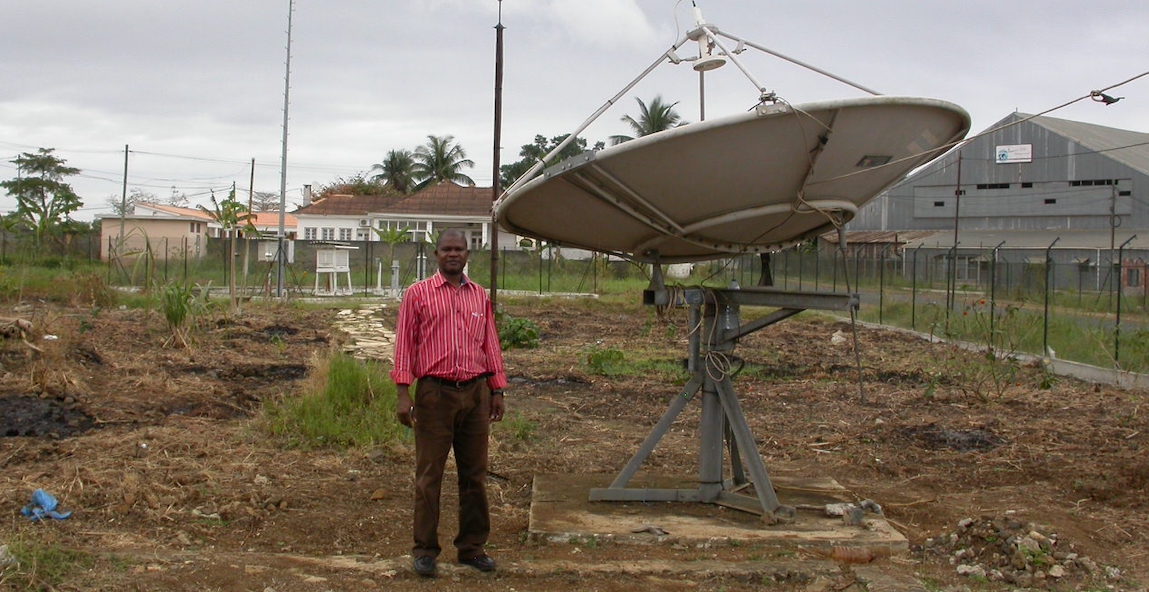
Photo:
This project, "Strengthening climate information and EWS in São Tomé and Príncipe to support climate resilient development", responds to priorities and actions identified in the NAPA of São Tomé and Príncipe which articulate the need for securing, transferring and installing critical technologies, as well as developing the necessary systems for climate change-related information to permeate into decision-making processes. The technologies required to achieve these aims will increase the capacity of the national early warning network to forewarn and rapidly respond to extreme climate events.
It is expected that as climate change unfolds the frequency and intensity of climate related shocks will change, therefore improving Early Warning Systems (EWSs) is one way to adapt to a changing climate. As an adaptive measure EWS also benefit the poorer segments of society, those who do not necessarily benefit from large protective infrastructure project. Furthermore, improving the EWS also provides benefits for long term planning and helps NHMS and other institutions build capacity to service other needs e.g. for land-use and agricultural planning, hydro-electric power etc.
- National
- National Governments
- National Institute of Meteorology, São Tomé and Príncipe
- United Nations Development Programme (UNDP)
- National Council for Preparation and Responses to Disasters,São Tomé and Príncipe
- Global Environment Facility (GEF)
The project is focused on strengthening the capacity of national and sub-national entities to monitor climate change, generate reliable hydro-meteorological information (including forecasts) and to be able to combine this information with other environmental and socio-economic data to improve evidence-based decision-making for early warning and adaptation responses as well as planning. The proposed project will be implemented at the country level by the lead Ministry mandated to advance climate monitoring including management of climate data in full collaboration with other relevant line Ministries who rely on the information for planning purposes (Disaster Management, Agriculture, Water, Finance and Planning etc). Sub national authorities (Provincial and/or District officers, Municipalities, civil society (women and youth associations, NGOs, media, farmers’ associations) and the private sector will all also be important stakeholders (as end users) and will be provided with the space and opportunity to contribute to the design of the project.
Project Objective: To strengthen the climate monitoring capabilities, early warning systems and available information for responding to climate shocks and planning adaptation to climate change in Malawi.
Outcome 1: Enhanced capacity of national hydro-meteorological (NHMS) and environmental institutions to monitor extreme weather and climate change.
- Output 1.1 Procurement and installation or rehabilitation (in case of existing) of approximately 10+ hydrological monitoring stations with telemetry, archiving and data processing facilities.
- Output 1.2 Procurement and installation or rehabilitation of approximately 40 meteorological monitoring stations with telemetry, archiving and data processing facilities.
- Output 1.3 Procurement and installation or rehabilitation of radar for monitoring severe weather.
- Output 1.4 Procurement and installation or rehabilitation of upper air monitoring stations
- Output 1.5 Procurement and installation or rehabilitation of satellite monitoring equipment to receive real time climate and environmental information.
- Output 1.6 Training of at least 3-5 officers to maintain and repair equipment, computer infrastructure and telecommunications , including cost-effective technologies to interface with existing equipment/software (approx. $150,000).
Outcome 2. Efficient and effective use of hydro-meteorological and environmental information for making early warnings and long-term development plans.
- Output 2.1 NHMS capacity to make and use climate forecasts (on daily to seasonal, as well as medium- to long-term timescales) is strengthened by training at least 4 forecasters. (approx. $150,000)
- Output 2.2 Tailored sector-specific early warning products that link climate, environmental and socio-economic information on a range of timescales are developed, based on identified user needs.
- Output 2.3 National capacity for assimilating forecasts and monitoring into existing development planning, PRSPs and disaster management systems is built, including coordination with systems and warnings developed by other initiatives (approx. $390,000)
- Output 2.4 Communication channels and procedures for issuing warnings (through both governmental and non-governmental agencies) are enabled (e.g. radio, newspapers, mobile phones, television etc).
- Output 2.5 Plan for sustainable financing for the operation and maintenance of the installed EWS developed and implemented, including public and private financing options (approx. $150,000)
The implementation of the project’s activities will reflect UNDP-GEF monitoring and evaluation standards and procedures, in line with the requirements of the LDCF. Details for monitoring and evaluation will be articulated during the project development phase.
- UNDPMark TadrossRegional Technical Advisor
